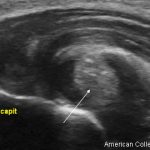TR: What conditions is ultrasound being used for outside inflammatory arthritis? What developments are coming down the pipeline in ultrasound that you’re most excited about?
JA: We’re now in the era where we’re calling it systemic rheumatic ultrasound, not musculoskeletal ultrasound. It’s being used to assess the parotid and salivary glands in Sjögren’s disease and temporal arteries in giant cell arteritis. My particular research has looked at using ultrasound to evaluate myositis, as well as diaphragm excursion and movement, and this is just the beginning.
MK: The future of ultrasound is already here. Portable, wireless handheld ultrasound devices are improving in image clarity and vascularity assessment at a rapid rate, and costs for these devices will become more affordable as technology continues to advance. A few medical schools throughout the [U.S.] have already given handheld ultrasound devices to every medical student to learn sonoanatomy, pathology and physiology. Contrast-enhanced ultrasound can enhance image quality and improve sensitivity to vascularity/inflammation among various tissues (e.g., joint vs. tendon).
Ultrasound elastography, commonly used to identify fibrosis in liver scans, can be applied to musculoskeletal applications to measure muscle, tendon and tissue properties of stiffness. Tele-ultrasound capabilities are allowing novice learners in remote locations to receive expert feedback. Lastly, software to include artificial intelligence (AI) technology will assist ultrasound users to more easily identify abnormalities vs. normal structures.
TR: Is it worth ordering a musculoskeletal ultrasound with radiology if I’m not trained in rheumatology ultrasound?
JA: Honestly, no. It’s really something that a rheumatologist should be doing. If you’re sending a patient to radiology for hand ultrasound, they aren’t going to know what to do. Rheumatology has our own protocols. Radiology is used to looking for cysts or masses, not synovitis, tophi or erosions.
TR: Guidance on ultrasound was last issued by the ACR in 2012. Are there any efforts to update these guidelines coming down the pipeline?


